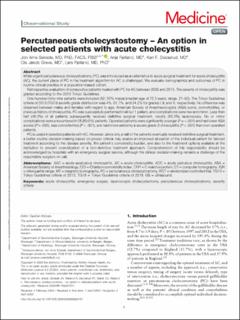| dc.description.abstract | While urgent percutaneous cholecystostomy (PC) was introduced as an alternative to acute surgical treatment for acute cholecystitis (AC), the current place of PC in the treatment algorithm for AC is challenged. We evaluate demographics and outcomes of PC in routine clinical practice in a population-based cohort.
Retrospective evaluation of consecutive patients treated with PC for AC between 2000 and 2015. The severity of cholecystitis was graded according to the 2013 Tokyo Guidelines.
One hundred forty-nine patients were included (82; 55% males) (median age of 72.5 years; range, 21–92). The Tokyo Guidelines criteria of 2013 (TG13) severity grade distribution was 4%, 61.7%, and 34.2% for grades I, II, and III, respectively. No difference was observed between males and females with regard to age, American Society of Anesthesiologists (ASA) score, comorbidities, or previous history of cholecystitis. PC was successfully performed in all but 1 patient, and complications were few and minor. Less than half (48.3%) of all patients subsequently received definitive surgical treatment, mostly (83.3%) laparoscopy. No or minor complications were encountered in 58 (80.6%) patients. Operated patients were significantly younger (P = <.001) and had lower ASA scores (P = .005), less comorbidities (P < .001), and had more seldomly a severe grade 3 cholecystitis (P < .001) than non-operated patients.
PC is useful in selected patients with AC. However, since only a half of the patients eventually received definitive surgical treatment, a better routine decision-making based on proper criteria may enable an improved allocation of the individual patient for tailored treatment according to the disease severity, the patient's comorbidity burden, and also to the treatment options available at the institution to prevent overutilization of a non-definitive treatment approach. Comprehension of this responsibility should be acknowledged by hospitals with an emergency surgical service, although the clinical decision-making remains a challenge of the responsible surgeon on call. | en_US |

